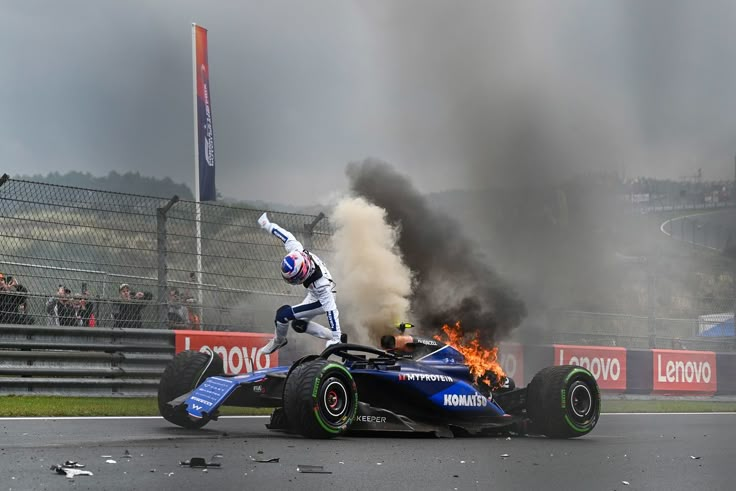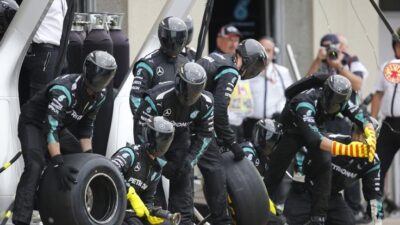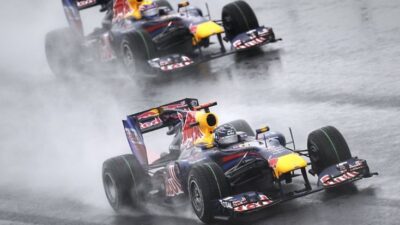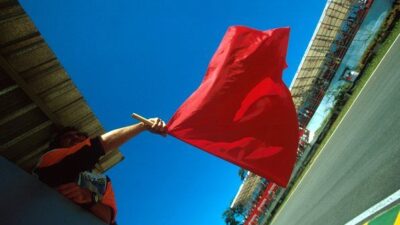Racing has always been dangerous, but some crashes changed everything. Throughout motorsport history, tragic accidents have forced the sport to completely rethink how it protects drivers, crews, and fans. These devastating moments became turning points that saved countless lives.
The deadliest accidents in motorsport history led to the most important safety innovations we see today. From the 1955 Le Mans disaster that killed 83 spectators to Dale Earnhardt’s fatal crash at Daytona, each tragedy sparked new rules and technology. Racing organizations learned that speed and safety must work together.
The crashes that seemed like endings actually became new beginnings. Fatal motor-sports crashes led to better safety regulations that protect everyone at the track. Every safety net, helmet design, and track barrier exists because someone before paid the ultimate price to make racing safer.
Key Takeaways
- Major racing accidents throughout history forced motorsport to develop life-saving safety innovations
- Tragic crashes at famous races like Le Mans and Daytona created the safety standards used today
- Modern racing safety technology exists because past accidents showed what needed to change
The 1955 Le Mans Disaster: Motorsport’s Defining Tragedy
The June 11, 1955 crash at Circuit de la Sarthe killed 83 spectators and driver Pierre Levegh when his Mercedes-Benz 300 SLR launched into the crowd. The chain reaction started during intense competition between Mercedes, Jaguar, and other manufacturers, leading to immediate safety changes across motorsport.
Lead-Up to the Catastrophe
The 1955 24 Hours of Le Mans featured fierce competition between top manufacturers. Mercedes-Benz brought their advanced 300 SLR cars driven by Pierre Levegh and other skilled racers.
Jaguar fielded a strong team including Mike Hawthorn. The rivalry between these teams created intense on-track battles throughout the early hours of the race.
Key competitors included:
- Mercedes-Benz with the 300 SLR
- Jaguar D-Type team
- Ferrari entries
- Austin-Healey works cars
The Circuit de la Sarthe layout prioritized speed over safety. Spectators sat close to the track with minimal barriers protecting them from racing cars.
Cars reached high speeds on the Mulsanne straight before braking hard for the pit area. This created a dangerous situation where fast-moving cars mixed with slower traffic entering the pits.
The track design from 1955 would be considered extremely dangerous by modern standards. Safety measures that exist today simply did not exist then.
The Collision and Its Aftermath
At 6:26 PM, Mike Hawthorn’s Jaguar made a sudden move toward the pits. Lance Macklin’s Austin-Healey swerved to avoid the Jaguar, putting it directly in Pierre Levegh’s path.
Levegh’s Mercedes-Benz 300 SLR hit the Austin-Healey at high speed. The impact launched the Mercedes into the air and over a small embankment into the spectator area.
The crash sequence:
- Hawthorn moves to pit lane entrance
- Macklin swerves left to avoid collision
- Levegh strikes Macklin’s car from behind
- Mercedes launches airborne into crowd
The Mercedes exploded on impact with the packed grandstand. The magnesium-bodied car burned intensely, making rescue efforts extremely difficult.
The disaster killed 83 spectators and Pierre Levegh, while injuring nearly 180 others. Debris from the car, including the engine and hood, flew into the crowd causing most casualties.
Race officials controversially decided to continue the race. They believed stopping would create panic and interfere with rescue operations.
Immediate Changes in Safety Protocols
Mercedes-Benz withdrew from the race immediately after the crash. The team also pulled out of motorsport completely, not returning until the late 1980s.
Several countries banned motor racing following the disaster. Switzerland implemented a complete ban on circuit racing that lasted for decades.
Circuit de la Sarthe modifications included:
- Barriers: New protective barriers between track and spectators
- Pit lane changes: Safer entry and exit design
- Spectator areas: Moved viewing areas further from high-speed sections
Car manufacturers began developing safety equipment. Fire-resistant materials became standard in racing car construction.
Race organizers implemented stricter crowd management rules. Spectators were kept at greater distances from dangerous track sections.
The FIA (international racing governing body) established new technical regulations. These focused on car construction standards and track safety requirements.
Safety equipment introduced:
- Fire suppression systems
- Improved driver restraints
- Fuel tank protection
- Stronger car structures
Racing continued at Le Mans, but the sport had changed forever. The 1955 disaster became the catalyst for modern motorsport safety standards.
Formula 1 Tragedies That Transformed Driver Protection
The deaths of Ayrton Senna and Roland Ratzenberger during the 1994 San Marino Grand Prix marked Formula 1’s darkest weekend and triggered the most comprehensive safety overhaul in the sport’s history. These tragedies led to immediate rule changes, extensive cockpit redesigns, and new car safety features that continue to protect drivers today.
1994 San Marino Grand Prix: Senna & Ratzenberger
The 1994 San Marino Grand Prix weekend became a turning point for Formula 1 safety. Roland Ratzenberger died during Saturday qualifying when his Simtek car crashed at high speed.
Ayrton Senna, the three-time world champion, was killed the following day. His Williams car left the track at Tamburello corner and hit a concrete wall at approximately 145 mph.
The weekend had already seen multiple accidents in testing and practice sessions. These incidents exposed serious flaws in Formula 1’s safety standards.
The sport had recently banned electronic aids like active suspension, ABS, and traction control for the 1994 season. Williams had relied heavily on these systems in previous championship-winning seasons.
Without these electronic helpers, cars became harder to control and more dangerous to drive.
Safety Rule Changes After Imola
Formula 1’s governing body reacted quickly to the Imola tragedies. By the Spanish Grand Prix, just two races later, teams faced new restrictions on front wing endplates and diffuser lengths to reduce downforce.
Key immediate changes included:
- Modified front wing endplate designs
- Shortened diffusers to cut aerodynamic grip
- Holes cut into airboxes to reduce engine power
- Introduction of wooden planks under cars
The wooden plank system became one of the most important safety innovations. Teams had to install planks on the car floor to control ride height during races.
The plank could not wear down more than 1mm during a race. This rule famously led to Michael Schumacher’s disqualification at the Belgian Grand Prix when his plank exceeded wear limits.
Teams also faced new rear wing restrictions. An exclusion zone 150mm behind the rear axle line eliminated pre-wing designs.
Evolution of Cockpit and Car Design
The 1995 season brought even more dramatic safety improvements to Formula 1 cars. Engine capacity dropped from 3.5 to 3.0 liters to reduce power and speeds.
Major cockpit changes included:
| Safety Feature | 1994 | 1995 |
|---|---|---|
| Cockpit side height | 400mm | 550mm |
| Cockpit width | 450mm | 420mm |
| Monocoque extension | Standard | +150mm forward |
The monocoque grew 150mm longer in front of the axle line. This created better crush zones to protect drivers’ feet during frontal impacts.
Higher cockpit sides provided better protection against debris and side impacts. New side impact tests joined existing crash test requirements.
Load and impact testing became more severe with higher speeds and forces. A step plane lifted the outer floor sections by 25mm to further reduce downforce potential.
These changes increased car wheelbases and altered aerodynamic designs. The safety innovations following the Imola weekend established the foundation for modern Formula 1 safety standards that continue protecting drivers today.
American Racing’s Pivotal Accidents: Daytona and Indianapolis
Two American racing venues experienced crashes that fundamentally transformed motorsport safety. Dale Earnhardt’s fatal accident at the 2001 Daytona 500 sparked NASCAR’s comprehensive safety overhaul, while Indianapolis Motor Speedway’s deadly 1973 incident revolutionized IndyCar protection systems.
2001 Daytona 500: The Death of Dale Earnhardt
Dale Earnhardt’s death on February 18, 2001, marked the end of NASCAR’s old-school approach to safety. The seven-time champion crashed on the final lap of the Daytona 500.
Dale Earnhardt’s death sparked NASCAR’s safety revolution that changed everything. The wreck didn’t look severe enough to be fatal. This shocked the racing world.
Before 2001, nine drivers died in NASCAR’s top series over 11 years. After Earnhardt’s crash, zero drivers have died in major NASCAR races over the next 20 years.
Key Safety Changes After Earnhardt’s Death:
- Head-and-neck restraint devices became mandatory
- Safer barriers replaced concrete walls
- Carbon-fiber seats with better mounting systems
- Improved belt systems that don’t stretch
NASCAR opened its doors to outside experts for the first time. The sport abandoned its do-it-yourself culture and embraced scientific research.
Indianapolis 500: Historical Crashes and Their Consequences
The 1973 Indianapolis 500 experienced a deadly crash that opened the door for safety improvements at the famous speedway. This accident forced major changes to car design and track safety.
Indianapolis Motor Speedway implemented multiple safeguards after the 1973 tragedy. IndyCar cockpits were moved to better protect drivers’ legs and feet from impact.
Major Indianapolis Safety Improvements:
- Stronger cockpit materials called “tubs”
- Repositioned driver seating areas
- Enhanced fuel system protection
- Improved crash barriers around the track
The speedway also developed SAFER barriers before other tracks. These steel-and-foam walls absorb energy during crashes better than concrete.
IndyCar’s safety revolution happened decades before NASCAR’s changes. The American Automobile Association had overseen early Indianapolis 500 races before other sanctioning bodies took control.
Global Catastrophes and Their Ripple Effect in Motorsports
The 1903 Paris-Madrid race killed eight people and led to the first major safety reforms in competitive racing. Land speed record attempts pushed technology beyond safe limits, creating deadly innovations that shaped modern motorsports safety.
1903 Paris-Madrid: Early Lessons in Racing Dangers
The Paris-Madrid race of 1903 stands as motorsports’ first major disaster. Five of the worst crashes in motorsport history include this early tragedy that changed racing forever.
Key Fatal Incidents:
- Marcel Renault died when his car hit a tree
- Camille du Gast’s mechanic was killed in a crash
- Multiple spectators died from poor crowd control
The race was stopped at Bordeaux after covering only half the planned route. Eight people had died, including drivers, mechanics, and spectators.
French authorities banned road racing immediately after the disaster. This marked the first time government intervention changed motorsports safety rules.
The tragedy led to three major changes. Racing moved to closed circuits instead of public roads. Speed limits were introduced for the first time. Crowd control became a requirement for all future events.
Land Speed Record Attempts and High-Risk Innovation
Land speed record attempts pushed cars to dangerous extremes throughout the early 1900s. Drivers used experimental engines and untested designs at speeds over 200 mph.
Major Safety Innovations Born from Crashes:
- Roll cages – developed after multiple fatal rollovers
- Fire suppression systems – created following engine explosions
- Safety harnesses – implemented after ejection deaths
The Bluebird crashes of the 1960s killed Donald Campbell and led to stricter vehicle testing. His hydroplane disintegrated at 300 mph on Coniston Water in 1967.
Salt flat racing at Bonneville produced crucial aerodynamic discoveries. Cars became airborne at high speeds, leading to downforce technology that keeps modern race cars planted.
Record attempts used rocket and jet engines that exploded frequently. These failures created better fuel systems and engine containment methods used in all motorsports today.
Key Safety Innovations and Lasting Reforms
Motorsport accidents drove the development of critical safety equipment that protects drivers today. Fire-resistant suits emerged after fatal burns, while energy-absorbing barriers replaced concrete walls following devastating impacts.
Development of Fireproof Suits and Helmets
Early racing drivers wore regular clothing and leather helmets that offered minimal protection. Fatal fires in the 1960s forced racing organizations to mandate fire-resistant materials.
Nomex fabric became the standard for racing suits after DuPont developed it in the 1960s. The material can withstand temperatures over 700°F for several seconds. This gives drivers crucial time to escape burning vehicles.
Modern racing suit features include:
- Multi-layer Nomex construction
- Reinforced knees and elbows
- Built-in cooling systems
- Flame-resistant zippers and thread
Helmet technology advanced from basic leather caps to carbon fiber shells with impact-absorbing foam. The FIA now requires helmets to survive impacts of 275G forces.
Today’s helmets include HEPA air filtration systems and advanced communication equipment. Some helmets also feature heads-up displays showing lap times and car data.
Introduction of Track Barriers and Run-Off Zones
Concrete walls lined early race tracks and often killed drivers on impact. The 1970s brought safer barrier designs that absorb energy instead of reflecting it back.
Armco barriers became popular in Formula 1 during the mid-1970s. These steel guardrails bend and deform to absorb crash energy. They replaced solid concrete walls at most major racing circuits.
SAFER barriers revolutionized oval track racing after their introduction at Indianapolis Motor Speedway in 2002. The Steel And Foam Energy Reduction system uses steel tubes backed by foam blocks.
Key barrier improvements include:
- Energy-absorbing foam backing
- Reduced impact forces by up to 40%
- Lower rates of serious head injuries
- Better debris containment
Gravel traps and run-off zones give drivers space to slow down safely. Modern tracks feature multiple safety zones designed for specific corner speeds and crash angles.
The HANS Device and Advanced Restraint Systems
Basilar skull fractures killed several NASCAR drivers in the late 1990s and early 2000s. These injuries occur when the head snaps forward violently during frontal impacts.
The Head and Neck Support device became mandatory in most racing series by 2005. Safety innovations in motorsports show the HANS device reduces head movement by up to 44% during crashes.
The carbon fiber collar sits on the driver’s shoulders and connects to the helmet with tethers. It prevents the head from snapping forward while allowing normal movement during racing.
Six-point harnesses replaced basic seatbelts in racing cars. These systems distribute crash forces across the driver’s chest, shoulders, and pelvis instead of just the waist.
Advanced restraint features:
- Automatic belt tensioners
- Quick-release mechanisms
- Fire-resistant webbing materials
- Energy-absorbing buckles
Impact of ABS and Modern Vehicle Technologies
Anti-lock Braking Systems first appeared in racing during the late 1980s. ABS prevents wheel lockup and maintains steering control during emergency braking situations.
Electronic stability control systems help drivers maintain control during oversteer and understeer conditions. These systems apply individual wheel brakes and reduce engine power automatically.
Traction control prevents wheel spin during acceleration by managing engine power delivery. The technology became standard in Formula 1 before being banned to maintain driver skill requirements.
Data logging systems now monitor every aspect of vehicle performance during races. Teams analyze crash data to improve safety equipment and identify dangerous track conditions.
Modern racing cars include impact sensors that automatically alert medical teams during crashes. Advanced safety technologies help emergency responders reach accident scenes faster with better preparation.
Current vehicle safety technologies:
- Real-time telemetry monitoring
- Automatic crash detection systems
- GPS-enabled emergency response
- Biometric driver monitoring
The Evolution of Motorsport Safety Culture
Major racing accidents transformed motorsport from a largely unregulated activity into a highly governed sport with strict safety protocols. This cultural shift involved regulatory bodies implementing mandatory safety standards, manufacturers developing advanced protection systems, and the industry learning to maintain excitement while prioritizing driver and spectator welfare.
Governance and Regulatory Changes
Racing organizations fundamentally changed their approach to safety after catastrophic crashes changed motorsports forever. The FIA, NASCAR, and other governing bodies moved from reactive to proactive safety measures.
Key Regulatory Milestones:
- Mandatory safety equipment standards
- Track design requirements
- Medical response protocols
- Driver licensing and training programs
The 1955 Le Mans disaster prompted racing authorities worldwide to establish comprehensive safety frameworks. Switzerland banned motor racing entirely, while other nations implemented strict oversight measures.
Modern regulatory bodies now require detailed safety assessments before approving new tracks or racing formats. They mandate regular equipment inspections and enforce penalties for safety violations.
Racing organizations also established dedicated safety research departments. These groups analyze crash data and develop new protection standards based on real-world incidents.
The Role of Manufacturers and Racing Teams
Automotive manufacturers transformed their racing priorities after high-profile accidents highlighted safety deficiencies. Companies like Mercedes-Benz temporarily withdrew from racing following the 1955 Le Mans tragedy, demonstrating how safety concerns affected corporate participation.
Manufacturer Safety Innovations:
- Carbon fiber monocoques
- Advanced helmet technology
- Fire suppression systems
- Energy-absorbing barriers
Racing teams now employ dedicated safety engineers alongside performance specialists. These professionals focus exclusively on protecting drivers rather than maximizing speed.
Mercedes-Benz returned to motorsport with enhanced safety commitments, investing heavily in crash testing and protective technologies. Other manufacturers followed similar approaches, treating safety as a competitive advantage rather than a constraint.
Teams also collaborate with safety organizations to share accident data and improve protective equipment. This cooperation replaced the previous culture of secrecy around crash information.
Balancing Spectacle and Safety in Modern Racing
Modern motorsport faces the ongoing challenge of maintaining excitement while ensuring participant safety. The evolution of motorsport safety shows how the industry adapted without losing its appeal to fans.
Safety vs. Entertainment Balance:
- Restrictor plates limiting speeds on superspeedways
- Run-off areas that allow for recovery
- Safety cars that bunch the field during dangerous conditions
- Advanced medical facilities at every venue
Television coverage now emphasizes safety technologies alongside racing action. Broadcasters explain how modern cars protect drivers during crashes, educating viewers about safety improvements.
Racing series implement rules that encourage close competition while preventing dangerous situations. These regulations often limit top speeds or require specific safety equipment based on track characteristics.
Fan areas receive the same attention as driver protection. Modern facilities include debris fencing, protected viewing areas, and emergency evacuation procedures that keep spectators safe without compromising their racing experience.
Frequently Asked Questions
Fatal crashes in motorsport have led to specific safety rules and new technology that protect drivers today. These changes include better helmets, stronger car designs, and new track safety measures.
What are the key safety regulations introduced as a result of fatal motorsport accidents?
NASCAR requires all drivers to wear head and neck protection devices after Dale Earnhardt’s fatal crash in 2001. The organization also mandated carburetor restrictor plates to limit speeds after Bobby Allison’s airborne crash at the 1987 Winston 500.
Formula 1 reduced engine sizes and raised cockpit sides following Ayrton Senna’s death in 1994. The sport also requires stronger wheel attachments to prevent suspension parts from entering the driver area.
Safety nets now cover NASCAR car windows after Richard Petty’s arm was severely injured when it went outside his car during a 1970 crash. Special spoilers deploy automatically when cars get turned around to prevent them from becoming airborne.
How did Ayrton Senna’s death lead to changes in Formula 1 safety?
Senna’s fatal crash at the 1994 San Marino Grand Prix prompted major rule changes in Formula 1. The sport limited engine power and raised cockpit walls to give drivers more protection.
Formula 1 changed how suspension systems work to stop wheels from breaking off during crashes. The front wings and diffusers became smaller to slow the cars down.
Track design also changed after Senna’s accident. New circuits have more space between the racing line and concrete walls so cars can slow down before hitting barriers.
Which technological advancements in car design have been made in response to racing accidents?
Modern race cars use containment seats and headrests that reduce the forces on a driver’s head and neck during crashes. These designs help prevent the severe head and spine injuries that have caused several fatalities in motorsport incidents.
Stronger safety cages now surround drivers in all major racing series. Carbon fiber construction provides better crash protection while keeping cars lightweight.
Cars feature larger spoilers and wings to maintain stability at high speeds. Data collection systems monitor how safety equipment performs during impacts to guide future improvements.
What impact did the accidents at Le Mans ’55 have on motorsport safety protocols?
The 1955 Le Mans crash that killed between 70 and 130 spectators led to major safety changes across all motorsport. Pierre Levegh’s crash into the crowd showed that simple barriers were not enough protection.
France banned car racing until tracks and cars became safer. Switzerland still prohibits car racing today because of this accident.
Racing circuits worldwide added stronger barriers and moved spectator areas farther from the track. Emergency response procedures also improved to handle crashes more effectively.
How has driver safety gear evolved due to past motorsport tragedies?
The HANS device became mandatory in many racing series after studies showed it prevents fatal head and neck injuries. This system connects the helmet to the car’s safety cage to limit dangerous head movement.
Modern helmets use advanced materials and designs tested specifically for high-speed impacts. Fire-resistant suits now provide better protection and allow drivers more time to escape burning cars.
Six-point harness systems replace older seat belts to distribute crash forces across the driver’s body. These restraints work with specially designed seats to keep drivers secure during rollovers and impacts.
What role has data analysis played in enhancing safety measures post-accidents?
Crash data recorders in modern race cars capture information about impact forces and how safety systems perform. This data helps engineers design better protection equipment and understand what happens during accidents.
Computer simulations use real crash data to test new safety designs before they reach the track. Teams can predict how changes will affect driver safety without putting anyone at risk.
Telemetry systems monitor car behavior in real-time and can warn drivers about dangerous conditions. This technology helps prevent accidents by giving early warnings about mechanical problems or track hazards.











